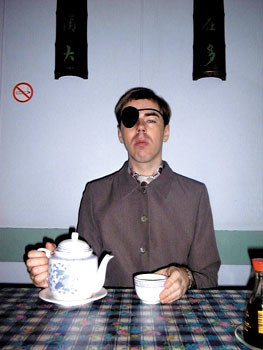With a Hey-nonny-nonny and Plenty of Irony
As music journalists have often remarked Nick Currie aka Momus is “the most underrated man in pop”. With a career that spans Weil-style cabaret, top 10 J-pop hits, his polymathematical ‘thoughts for the day’, to some of the wittiest and wordiest songwriting there is, he’s probably too slippery to be spun. With a reputation like this don’t be surprised to find him explaining why folk is the way forward.
 I’VE JUST STARTED RECORDING A PLASTIC FOLK ALBUM.
I’VE JUST STARTED RECORDING A PLASTIC FOLK ALBUM.
I don’t think anyone can really be authentic in music any more. We’re exposed to so many different styles from birth that no single one of them can be a natural and inevitable choice for a musician. Even gypsies are probably exposed to as many Michael Jackson records as they are to the fiddle music of their ancestors, so if they choose to play ‘gypsy music’ it’s arbitrary – a pose, a game.
In the electronic age we’re all rootless. We’re electronic gypsies. In my inverted world the closest you can get to authenticity is highlighting your own fakeness. As Adorno put it: “In the end, soul itself is the longing of the soul-less for redemption.”
For a couple of years now I’ve been fascinated by the novelty records of the early electronic era. Designed to demonstrate the Moog synthesiser, these records took baroque classical music and rendered it into electronic sound. The net result was full of fascinating collisions: art meets science, the past meets the future, high culture meets low, Europe meets America, and incredible feats of musicianship are put in the service of novelty and kitsch.
In the late 60s music of just about every genre got the novelty Moog treatment. It was a bit like what happened when music went digital in the 80s: for a while it seemed like the whole history of human music had to be ‘taught’ to the baby format. As if we humans were parents teaching the new electronic life forms – Moog, CD, PC – our history. The Moog learned Bach, it learned ragtime (I have a record called ‘Turned On Joplin’), it learned novelty pop and prog rock.
The one thing the Moog didn’t learn much about, though, was folk and ethnic music. I suppose it would have seemed a bit too perverse to play ‘Saccho And Vanzetti’ or Dogon drum music on the synthesiser. These musics were vested with too much humanist dignity, too much authenticity, to be played on a gimmicky new electronic gizmo. (Someone did recently send me an Australian Moog record from the early 70s called The Moog Goes Folk. It’s horrible.)
Of course, the meaning of the analog synthesiser has changed in culture since the 60s. Where once it was cold, futuristic, cutting edge, high tech, now it’s warm, fuzzy, nostalgic, laughably primitive. To use a Moog now might seem kitschy if it weren’t for the inherent strangeness of the sound: gloopy, awkward, stubborn, reedy, brutal, fat. The Moog sound is a throwback to the days when electronics really did sound electronic. Now a synthesiser sounds like anything you care to imagine; it’s lost its identity as a musical instrument.
My last two albums, The Little Red Songbook and Stars Forever, are in a style I call Analog Baroque. They use as their stylistic template the 1960s tradition of Moog renditions of classical music. But now I’m moving from Analog Baroque to Fake Folk.
On my 1999 album Stars Forever there were already a couple of electronic sea shanties and English maypole songs full of ‘hey-nonny-nos’ played on analog synths. Now I’m going the whole hog. It’s time for the Moog to learn Folk.
It opens up whole vistas of irony and speculation. What if the Appalachian Mountain musicians had used Moogs instead of fiddles? What if Jean Michel Jarre records had infested the ‘purity’ of aboriginal music and fragments of Oxygene were discovered in field recordings made by UNESCO teams? Would our sentimental concept of authenticity survive?
Let’s see.
Nick Currie/Momus <nick AT momus.demon.co.uk>http://www.demon.co.uk/momus
Mute Books Orders
For Mute Books distribution contact Anagram Books
contact@anagrambooks.com
For online purchases visit anagrambooks.com







